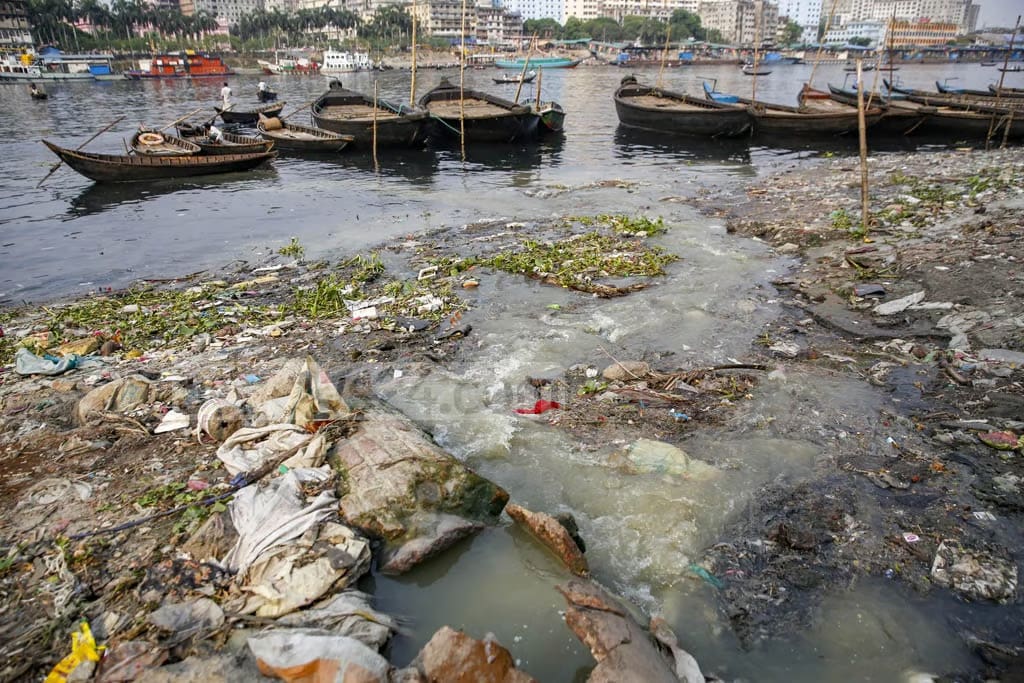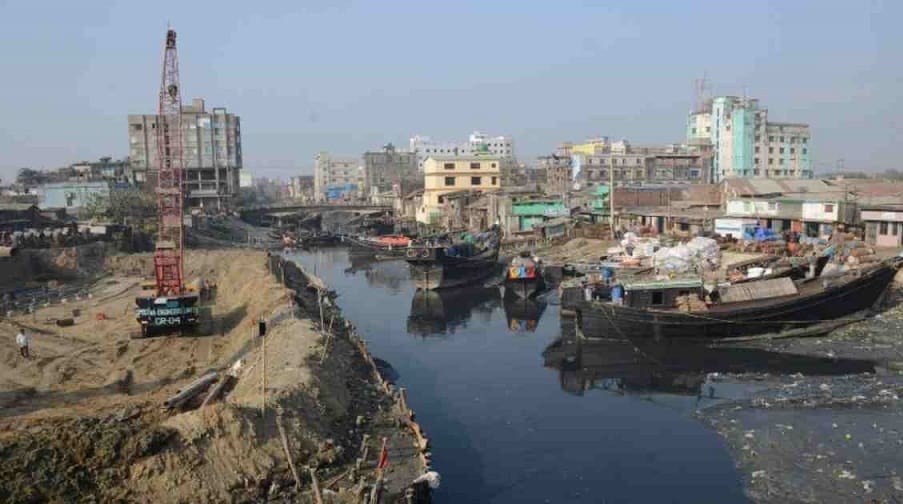The Buriganga River was once the lifeline of Dhaka. But with the passage of time, it turned to a dead river due to the pollution from widespread dumping of industrial and human wastes.
The old Buriganga Restoration Project aims to restore the highly polluted Buriganga, that would help Dhaka’s revival. The old channel is located in the middle of Shahidnagar-Hazari bagh embankment of Old Dhaka and Kamrangirchar. Various structures were built on the two sides of the area, which occupied about seven kilometres.
Reduced Waterlogging
Commute from Buriganga to Turag River
Cost-effective Goods Transportation
The recovery of the channel will free Dhaka’s Hazaribagh, Lalbagh, Dhanmondi, and Kamrangirchar from waterlogging. The seven-kilometer-long channel will make it convenient for Dhaka residents to commute from Buriganga to the Turag River and the transportation of goods will be cost-effective due to the reduction in cost. Under the project, the water development board targets to enhance 141 cusec water flow of the Buriganga River by bringing 245 cusec water flow from the river Jamuna during the dry season.
0
Cusec
Increased waterflow
The water of the Buriganga, Dhaleswari, Pungli, Bangshi and Turag had become very dirty, and the bad smell from the water and the pollution had started to effect the surrounding areas. During rainy months, the situation got better temporarily for a short period.
0
MT
Waste thrown into Buriganga everyday
The natural habitats of Buriganga, Turag, Balu and Shitalakkhya rivers had been disturbed because of the industrial and household wastes being thrown in them. The capital city Dhaka and Buriganga river and its tributaries are being contaminated with about 50000 metric tons of waste every day with 60 percent out of which is industrial.
Growing industry is a major contributor to the ecological decline of the river. There are high amounts of waste that comes from factories and mills and seeps into the water. It is seen that the river has changed its path because there’s a lot of polythene waste on the bed of the river. Locally the Buriganga river has recently been being known as ‘Plastic River’.

Bangladesh had made environmental-friendly effluent treatment plants mandatory for industrial use in 1995. But still, most industries do not abide by this rule leading to increased pollution in rivers. The local governance in charge of equity implementation don’t have enough personnel to carry out 24/7 monitoring. The impact of pollution is increased in the dry season and industrial sewage is the major cause of it, according to the River and Delta research center.
Budget and Finance
In 2010, the government started a project worth Tk 944 million in order to revive the river by diverting water from the transboundary River Jamuna to flush out the pollution with a timeline of three years. The dredging work was supposed to be carried out in a 162 km long river channel to connect the Jamuna to the river Buriganga. Brahmaputra River flows through India and Tibet and then merges into the Bay of Bengal. Part of this river is known as Jamuna. The water is transferred by shifting it from Bangabandhu Bridge along the Dhaleswari-Pungli-Bangshi-Turag-Buriganga system.
0
km
River Channel
The project was facing some great resistivity because of Dhaleswari in its way as a consequence to which the Bangladesh Water Development Board had to think about some other options in 2011. On the other hand, the deadline to complete the work extended till June 2015. In order to ensure the supply of clean water in River Pungli, Water Development Board emphasized constructing a guide dam and a basin. The acquisition of 85 hectares of land for the basin and guide dam increased the projected cost. The deadline for the project was extended to 2020, and further to 2022, said by Sirajul Islam, the executive engineer of the Water Development Board, Tangail.
Another project was approved at the meeting of ECNEC on 2018 to enhance the infrastructure of Buriganga, Turag, Shitalakshya and Balu rivers, for which around BDT 85 billion was allocated. The purpose of this venture was to stop the unauthorized people from invading the river banks of Buriganga, Turag, Shitalakshya and Balu.
Cost Overrun
The project created a problem for Bangladesh Inland Water Transport Authority. Expenditure increased in the budget on the protection of four river banks. The project’s initial cost was estimated to be Tk 848.55 crore. The project cost has been revised two times and its timeframe has been extended five times. The final revision of the project cost stood at BDT 1125.59 crore approximately. But in reality, a total of 1,181.82 crore was spent. In this instance, the price was increased by 39.21 percent.
BDT 84.85 Billion
Initially estimated
BDT 118.18 Billion
Actual cost
About 52 km walkway is planned to be constructed on the banks of Buriganga, Turag, Shitalakshya and Balu rivers. Once it is completed, work on the project to build another 148 km of walkways will begin from 2024.
Advancements Achieved
Even three years ago, the Buriganga river used to dry up during summer and kids used to play near the old channel. It became obsolete. With all the new updates over the past years, it is now easily recognizable as a branch of the huge Buriganga Network. The Dhaka South City Corporation (DSCC) has been working to revitalize the Buriganga channel since July, 2022.

The old channel’s original boundary ran from Muslimbagh in Kamrangirchar to Rayerbazar in Hazaribagh, covering a length of 7.5km. The DSCC is considering creating a new boundary and making the channel look like it used to be by enclosing it.
The government has already spent BDT 22 crore (2.2 billion) to remove wastes and slits from the channel and plans to remove the rest of the waste and silt from the channel with approximately Tk 14 crore. If the channel becomes operational, it will decrease waterlogging in Lalbagh, Hazaribagh, Dhanmondi, and Kamrangirchar areas.
As per the reports from the DSCC engineering department, after taking office, the mayor Fazle Noor Taposh immediately began planning ways to tackle the waterlogging problem. Visiting channel on April 3, 2023, it was discovered that the water flow was better and the amount of waste had decreased. Mostly, the channel’s waste and silt have been removed, and the remaining parts have their waste dumped on the banks. As per the officials in charge of the project, the first step was to clear the encroached areas of the channel and this entailed the removal of multi-storeyed buildings through drives. Subsequently, the cleaning operation was initiated. So far, 0.25 million tons of waste have been taken away from the river, and now the mayor aims to do a complete renovation on the entire waterway.
0
Mn
Tons of Waste Removed
According to the engineers who are involved in the development of this project, a consultancy firm was employed in October 2020 at a cost of nearly BDT 4.5 crore (0.45 Billion) to plan the transformation of this canal into an entertainment and leisure venue like Hatirjheel. It may take about four years to transform the original Buriganga channel into a beautiful one, according to the sources. Planning is ongoing to make the old Buriganga channel more spectacular than Hatirjheel, said Dhaka South City Corporation Mayor, Sheikh Fazle Noor Taposh. Since the old Buriganga channel is an open river basin, the scenario is slightly different. The city corporation has allocated BDT 25 crore (2.5 billion) in the first phase with its own financing for restoring the Buriganga channel and the primary stage of excavation has been completed with BDT 23 crore (2.3 billion). A budget of about BDT 35 crore (3.5 billion) more has been kept for the second phase and the differentiation is in progress. Moreover, modern facilities like walkways, cycle lanes and bridge will attract tourists.
Expansion
The GoB is planning to build four more bridges over the Buriganga in order to alleviate traffic congestion at the southern exit-entry points of Dhaka city as gridlocks at the entry-exit points of the capital’s south had worsened due to excessive traffic since the opening of Padma Bridge. But low-height and short-length bridges over rivers have the potential to kill the water bodies and increase pollution.
The Roads and Highways Department is considering building the bridges with “longer spans” keeping the river’s navigability in mind.
According to DSCC, major advancements have been achieved and the water flow can be observed now, although the water’s hue still remains dark and highly contaminated. Measures are being taken to purify the water. The Ministry of Shipping has almost completed the work of setting up the boundary pillars in large-scale structures on the river land. The project has so far witnessed around 82 percent progress.
Room for Improvement
According to a study by MDPI, the current river restoration project and the project’s investment plan is not sustainable. Moreover, the uncertainty of funds and carelessness of common people make the project uncertain.
The current Buriganga River Restoration Project, is not enough to maintain a standard water level in the future and it does not ensure long term effectiveness.
Though, the GoB has initiated three projects separately for increasing river flow, waste control and migration control, the results of these projects are uncertain.
Recommendations
- A thorough future trend analysis and dynamic impact assessment should be introduced for the project. It will help to make the project sustainable and useful.
- There should be comprehensive and quantitative metrics for analyzing the success of the project. Such metrics will help to keep a track of physical, ecological, social, water quality, and wetland vegetation characteristics.
- Due to the increase in population and population loads, there has been an increase in waste generation. This situation can make the river system a highly polluted one. Thus, waste management is necessary.
- The establishment of convenient communication channels for stakeholder participation in the restoration process is necessary. The opportunity to view the gains or losses of different stakeholders will increase their understanding of the active impact of the project.
- To determine the water quality, the DO/BOD ratio must be considered instead of considering only the DO value. Bec
Cover Photo: Big ships and small rowboats ply the river. © David Astley
About the Author

Hamim Mubtasim is the Brand Manager at The Confluence. He is currently pursuing his undergraduate studies at the Institute of Business Administration, University of Dhaka. A business student by choice and marketing geek by passion, he aspires to manage big brands someday.